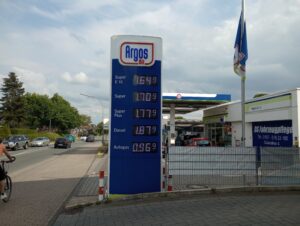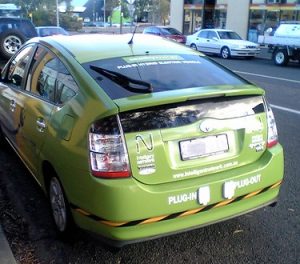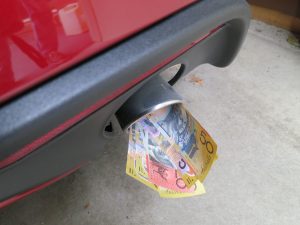On a recent trip to Germany we noticed that fuel prices were roughly $2.50AUD a litre for petrol and $2.75AUD a litre for diesel compared with $1.95AUD and $2.25AUD on average in Australia.
Despite this, the average German spends less on fuel than the average Australian while travelling similar yearly distances [1][2]. Here’s four ways to save on fuel costs like a German.
1. Accept higher fuel costs
Fuel is more expensive in Germany because of environmental taxes added to the per litre price of fuel so German motorists are used to higher fuel prices. While Australians don’t have this tax, we can’t get too complacent.
As of 2005, conventional oil production has declined, new sources of oil are getting harder to extract (shale oil, tar sands) and Australia has exhausted most of its oil supplies and now imports around 90% of its oil [3][4].
Even if Australian or foreign government intervention to prevent catastrophic climate change does not severely limit fuel supplies (or climate change itself), expect that fuel prices will trend higher in the future even if they continue to fluctuate.
The Russian invasion of the Ukraine has sent prices skyrocketing due to sanctions, yet Russia accounts for just 12% of the world’s oil supply [5]. This is worth keeping in mind if you have to buy another car in the future.

2. Buck the SUV trend and get a smaller car
If we had to describe SUVs in a word, it would be “disappointing”. On the odd occasion that we’ve been in one, we’ve found there’s hardly any extra interior or luggage space and they feel like a land yacht to drive in comparison to a good small/mid-sized vehicle.
Luggage space can be augmented in smaller vehicles by getting a wagon where possible or using a roof pod to carry extra luggage when needed.
The lack of SUVs is a big reason why German drivers used 6.2 litres/100km on average in 2019 compared to Australia’s 11.1 litres/100km in 2020 [6][7].
Whilst Germany does have a lot of small diesels, their fuel savings are marginal compared to the difference in vehicle size and weight [7].
Small cars pay you back in three ways:
- They cost half as much or even less to buy than a larger SUV so you’re in front already.
- They don’t need technology that has a high upfront cost or a long payback period that could be unfulfilled due to a part or system failure (as can potentially happen with EVs, PHEVs, hybrids, turbo diesels, turbo petrols, LPG engines and stop/start technology) [8].
- They use less fuel, need fewer resources to be manufactured and have simular C02 lifecycle emissions to a large EV sedan on Australia’s electricity grid [9]. Just to be clear, no car is green but a small car is a less-worse option.

3. fuel costs are a quarter of your running costs
It feels like the hyper focus on fuel prices distracts motorists from the fact that car based transport is expensive in general. Generally, registration and insurance make up a quarter of your car costs, fuel another quarter and depreciation, repairs and consumables make up the rest.
So in the grand scheme of things, the average Australian is paying $1000 a year or more on fuel which bites, but it can be easily outstripped by a vehicle price rise or a major component failure.
So what to do? As mentioned earlier, a smaller car can halve your depreciation costs (the money you have to put aside to get your next car as yours ages and wears out). This could save you $1500 a year quite easily.
Plus if you buy a smaller car for $25,000 (or less second hand) instead of $50,000 or more for an SUV, you might be able to buy it in cash saving you $500-$1000 in loan interest costs. The lower purchase price, fuel costs and interest saved can easily add up to $4000 a year or more.
4. Travel less
In 2008, one of us had a large car and traded it in for a mid-sized wagon which saved $1000 a year on fuel.
As great as that was, when we got rid of our last car in 2011, we jointly saved $15,000 a year compared to a two car household (including public transport costs, taxi fares, car hire and bike costs).
At the time of writing, this has added up to $170,000 making for a much shorter mortgage.
This is not as common in Australia but it is much more common in Germany. We have many friends there with one or no car and that includes friends with kids. Australia may be the land of the outback but in 2020, 77% of all kilometres travelled by passenger cars were in cities and urban areas because that’s where most people live [10].
So chances are you can sub out car trips for something cheaper like public transport, cycling, walking, doing something local instead, carpooling or combining your errands into fewer trips.
If the fresh air, exercise, company or time to read and relax isn’t enough motivation, the non-fixed car costs per kilometre (that is, everything besides registration, insurance and roadside assist) is about $0.50 a kilometre verses $0.05-$0.20 a kilometre for car alternatives.
As an example, to travel from our town to the nearest capital city and back costs $34-$50 depending on the time of day whereas it’s $120 by car. See going carfree for tips on how to free yourself from car costs altogether.
The price of fuel in Germany verses their lower real world fuel costs demonstrates that Australians have some buffer to play with in the face of rising fuel prices.
At one end, there’s the option of downsizing your car and at the other end there’s the option of reducing car based travel to the point of downsizing to a one or no car household.
Fluctuating oil prices are hiding the decline of cheap oil and the rise of disruptive climate change so it would be wise not to bank on cheap oil in the future and reap the benefits of cheaper travel now.
Posts HomePage
Further Reading:
[1] In the 2019/2020 financial year, the average Australian car travelled 11,100 kilometres: [2] In 2019, the average German car travelled 13,602 kilometres: [3] https://www.postcarbon.org/has-oil-peaked/ [4] https://www.ga.gov.au/digital-publication/aecr2021/oil [5] https://www.statista.com/topics/5399/russian-oil-industry/#dossierKeyfigures [6] https://www.ptua.org.au/myths/efficient/ [7] As shown on the graph, the average German diesel car was only 1 litre/100km better than the average German petrol car:https://www.iea.org/articles/fuel-economy-in-germany
[8] The Dog and Lemon guide has quite a lot of information on the myriad of things that can go wrong with these technologies. They’re in the business of selling something (car reviews) but at least they’re honest about what can go wrong with cars and the costs involved.
[9] A litre of petrol burned will produce 2.31kg of carbon dioxide (that seems unbelievable given that a litre of petrol weighs less than that, the reason is that when a molecule of carbon is released it combines with two molecules of oxygen to form carbon dioxide, hence it is heavier than the original amount of fuel burned).
So a small car averaging 7 litres/100km over a lifetime of 300,000km will produce 48.5 ton of C02 along with the estimated 12 ton to produce it, so we have a total of 60.5 ton. A long range electric car needs 20 ton of C02 for its manufacture and will produce 35 ton of C02 over a lifetime of 300,000km charging off the Australian grid for a total of 55 ton. This shows how close the two are, given that the original numbers are general estimates:
[10] https://www.abs.gov.au/statistics/industry/tourism-and-transport/survey-motor-vehicle-use-australia/latest-release